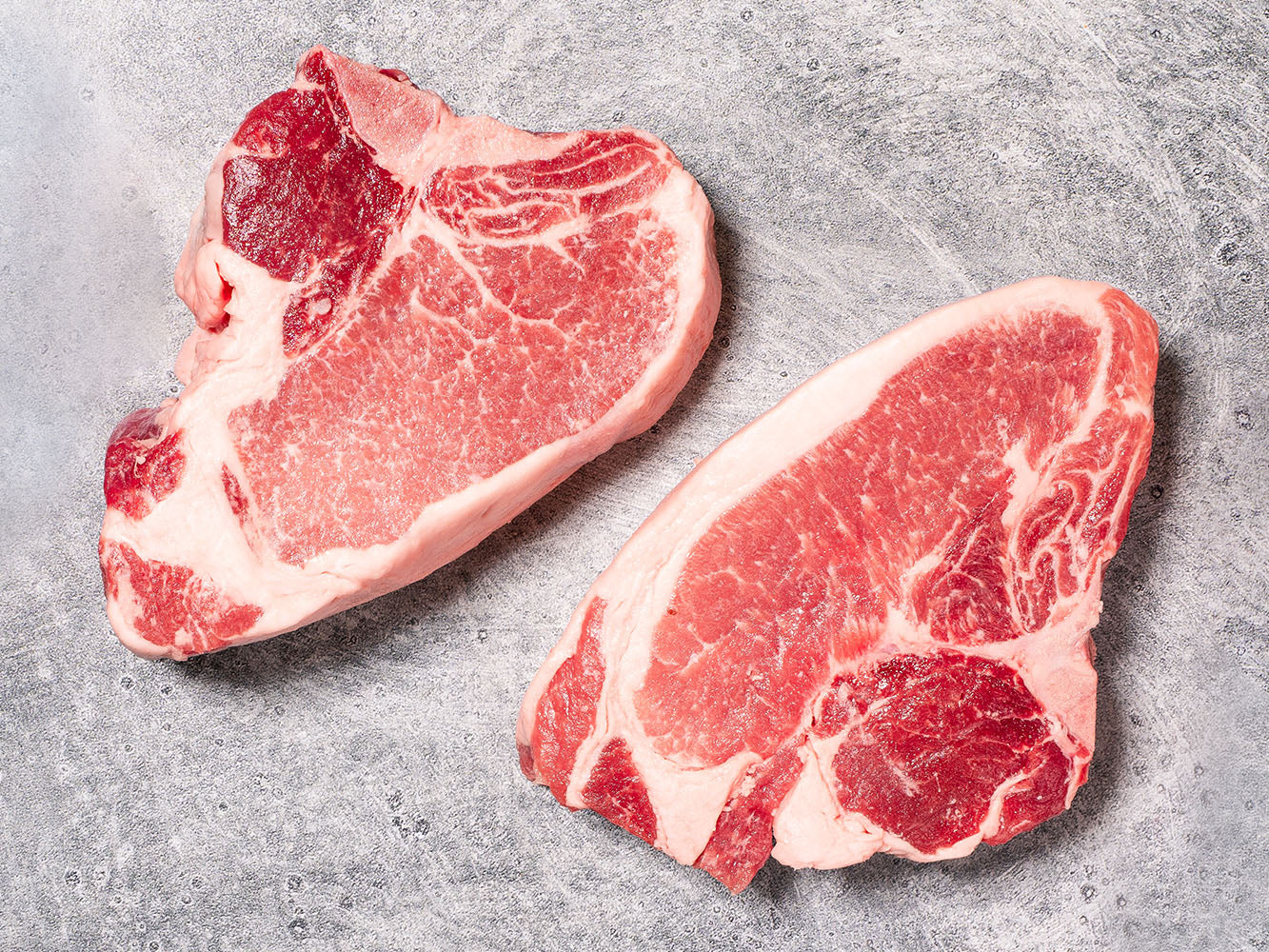


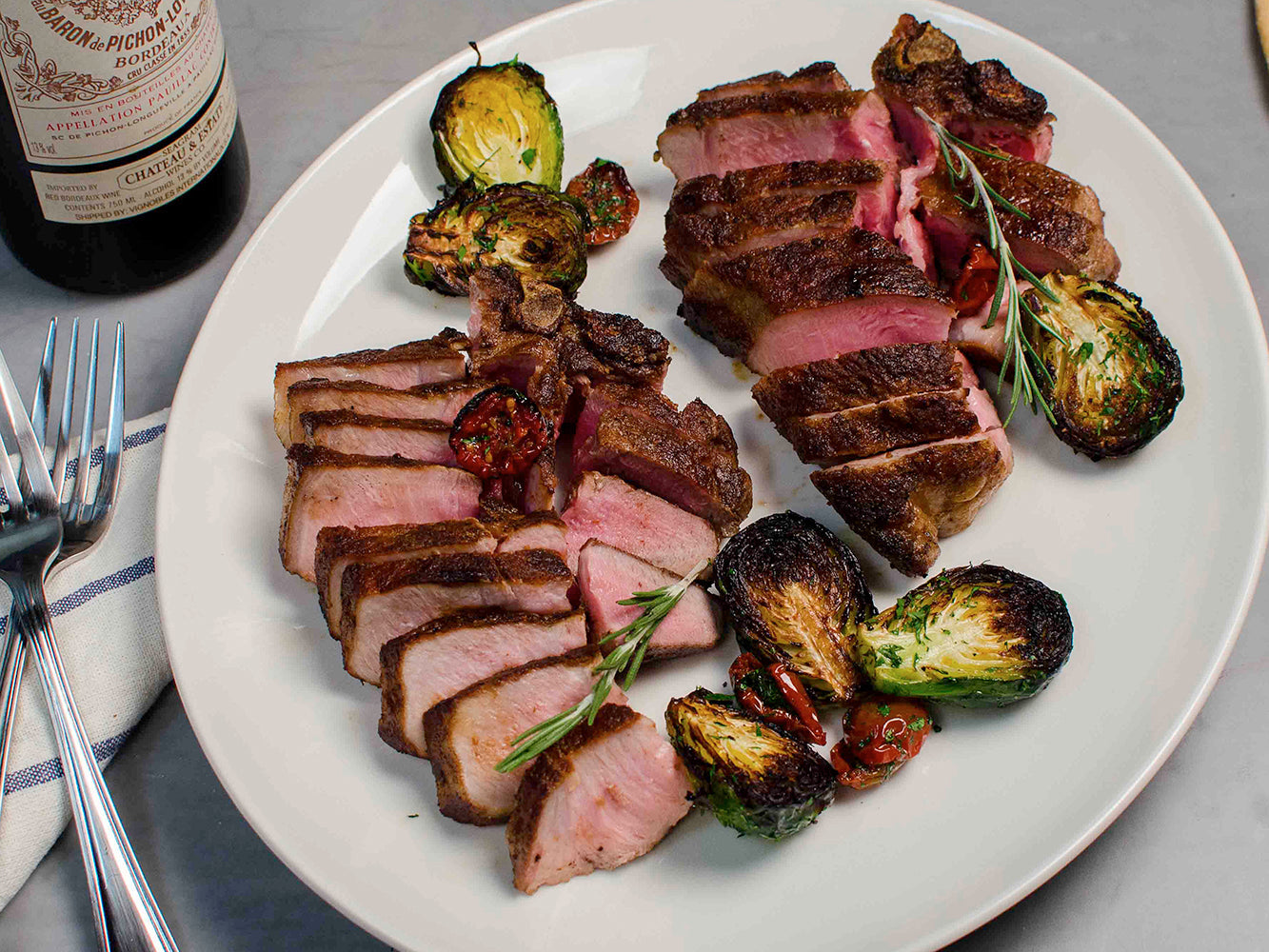
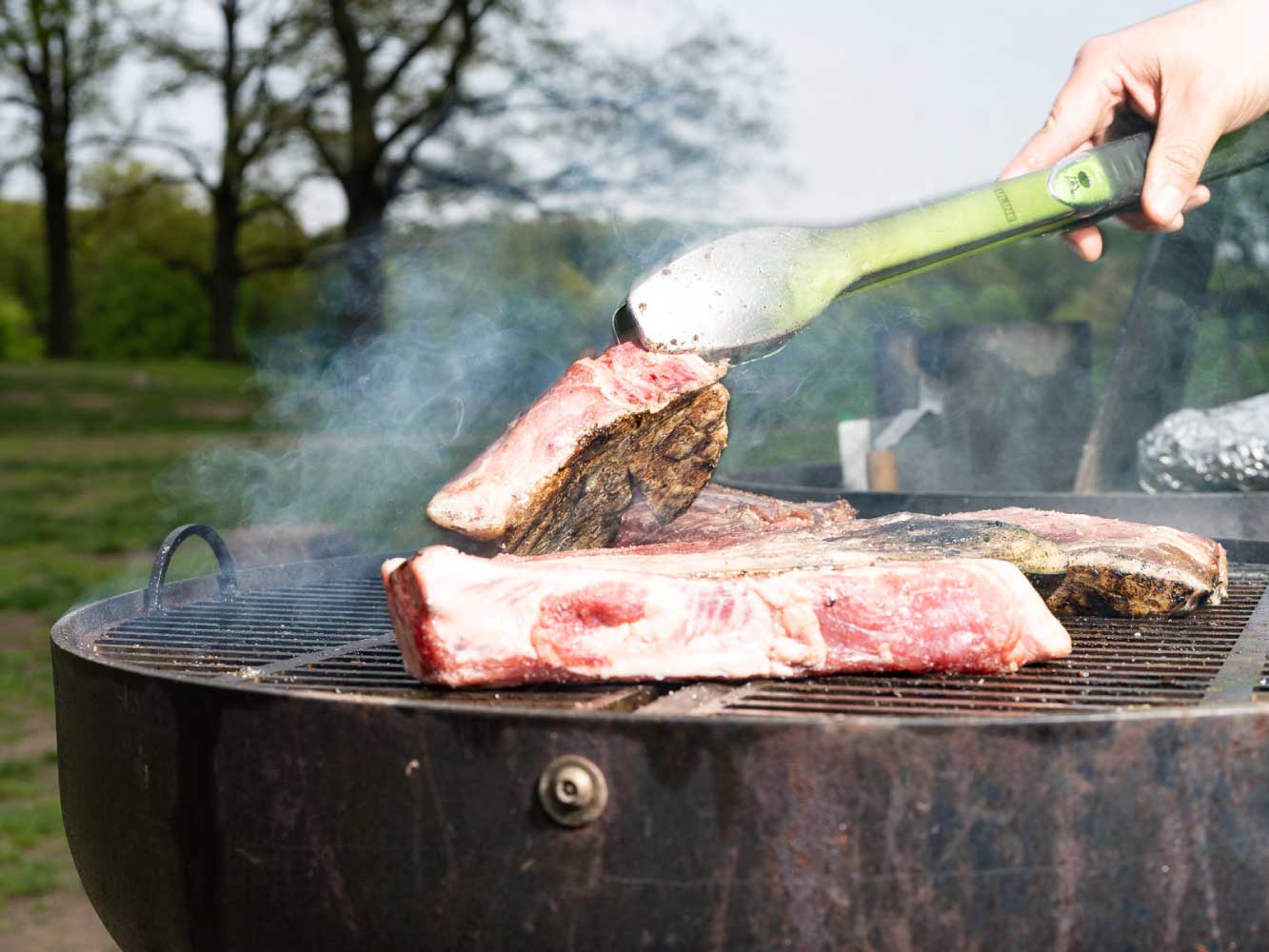
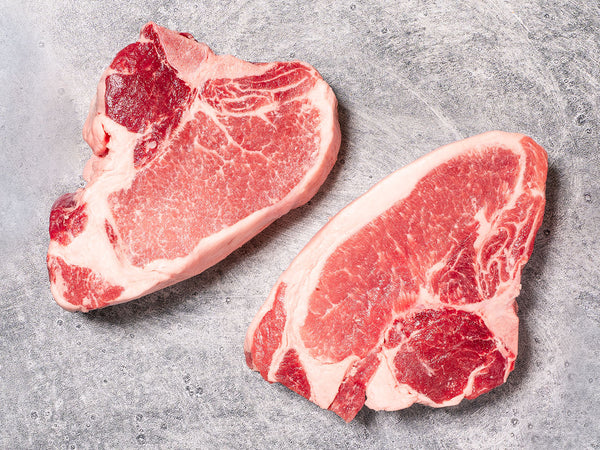


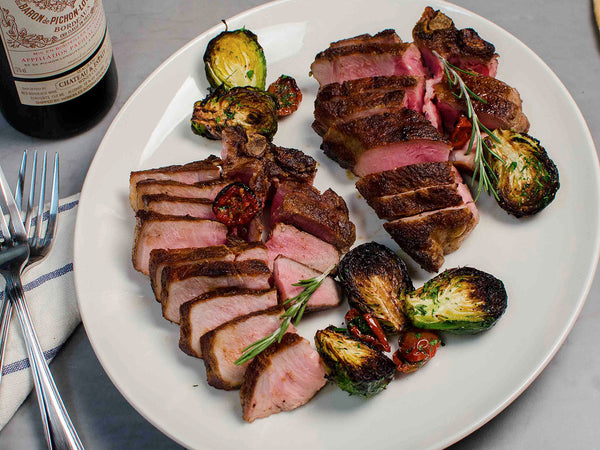
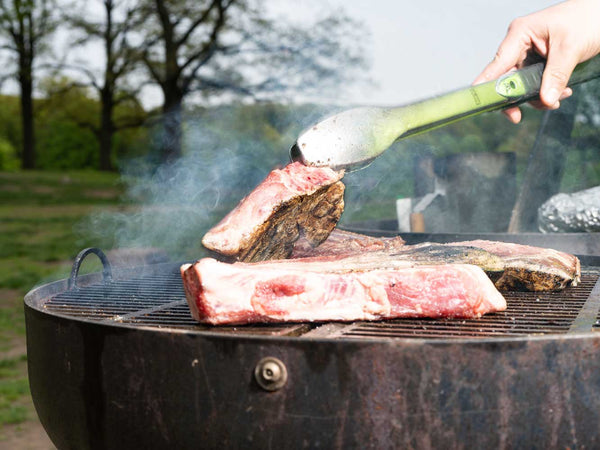





OUR TOP SELLER! — choose from six or fourteen 14 oz chops — from our selection of heritage breeds
Porterhouse Pork Chops
from our selection of heritage breeds
Two chops per package
Choose from six or fourteen 14 oz chops from the drop down menu above.
Our Number One Best Seller! These are the chops that put the words "Heritage pork" on menus throughout the country. The porterhouse is truly a fantastic cut —the T-Bone of pork. Marbled gorgeously, each piece includes both the tenderloin and loin section. These thick-cut chops make for a hearty and inexpensive sustainable meal anytime; they only take 30 minutes to defrost, cook, and serve! And two chops (one pack) served sliced can easily feed four!
The secret to great pork is to start off with great ingredients, and nothing beats our storied Heritage breeds — Berkshire, Red Wattle, Duroc, Gloucestershire Old Spot, and Tamworth. Each breed comes from a different culinary tradition, and boasts a distinctive, nuanced flavor.
When Heritage Foods started in 2001 we set out to sell heritage Thanksgiving turkeys. For three years our turkey project grew, but naturally mating turkey is a seasonal food and two of the three farmers we worked with to raise birds were looking for a more regular source of income if they were to continue working with us. So we committed to selling pork, which can be produced year round, as long as the breeds came from historic genetic lines, just like the turkeys. Now, 24 years later, Heritage Foods still works with those two original farms who together introduced the word “heritage pork” to hundreds of America’s best restaurants from coast-to-coast as well as thousands of homes through the Heritage Foods retail website.
Newman Farm Berkshire Pork
Myrtle, Missouri
In 2006 we got a handwritten letter from farmer Mark Newman asking us if Heritage Foods would ever consider selling his pasture raised old school Berkshire pigs. We said yes and a relationship grew that still continues today, now through his son David who has maintained the genetic line of Berkshires which can be traced back to the 17th and 18th century lines that came to these shores by way of the Berkshire region of England.
From the air, Newman Farm Berkshire Pork, in south central Missouri, in the heart of the Ozarks, looks more like a pioneer settlement or a holiday camp than any sort of pig farm. Wooden huts are scattered across green fields like bungalows, where contented Berkshire pigs live their lives, happily on-pasture.
Pigs on Newman Farm are raised 100% on-pasture. The sows raise their piglets in huts that dot the fields of the farm. The babies live inside the huts until they are old enough to jump over the 6-inch wooden board that blocks the entrance. Once they make the great leap, they have an entire field to run on and they can mingle with the other piglets from the other huts.
David Newman is both a farmer and scientist. “The farmer came first,” he laughs. His degrees are in animal science, and he holds a Ph.D in meat science and muscle biology, focused on meat quality. “As I became a scientist and got involved in education, I applied what I was learning to understand what we could do better.”
Berkshires were the favorite breed of British royalty and were first introduced to the New World in 1823. Since then, Berkshire bloodlines have remained exceptionally pure and have become a mainstay favorite of chefs and diners, legendary for their exceptionally bright pork flavor and thick, delicious fat cap. And if anyone were to question their excellence, just ask David. “It’s not a matter of opinion!” he insists, passionately. “It’s a scientific fact, Berkshires are the most marbled hog on the market today.” David is a master breeder and works hard to keep the lines on his farm separate and he is always working to improve the Berkshire breed on his farm.
David lives on the farm with his wife, Kristin, his mom Rita, and his two kids. “I got my start through my family. My parents were hog farmers, but primarily in the commercial pig business. In the 1980s my parents raised pigs in confinement. There were some very challenging economic times for everyone in production, and we realized we were going to have to do something differently. Kristin came from a family farming background also and is a major part of the operations success today, working for the farm along with their team of employees.
“In the 1990s my parents decided they wanted to go back to their roots. We were going to have to be very large to be successful in the commercial sector, and my father decided we should focus on quality. We changed our genetic program and our nutrition program. We became Certified Humane®, and we chose to focus on Berkshire pigs for their quality.”
David and his family are the future of American farming! They are young, energetic and very passionate about the future of agriculture. David and Kristin work with a team of farmers who raise their Berkshires to supply Heritage Foods and the national network of chefs who rely on his product for their menus.
Lazy Red Wattle Ranch
La Plata, Missouri
We met Larry and Madonna Sorell in 2002, as growers for Frank Reese and the Heritage Turkey Project. As their turkey flock grew in size, so did the Sorell’s importance to Heritage Foods.
When you see Red Wattle pork on a menu, what you are seeing is a five-state, twelve farm network founded by Larry and Madonna, dedicated to raising a storied breed that was once upon a time nearly extinct. Larry and Madonna are the heroes of this story, avatars of the heritage food movement, true believers who were destined to become the Guardians of the Red Wattle. They are proof positive of the ethos that when it comes to endangered livestock, “you have to eat them to save them.”
In the beginning, back in 2004 when the Heritage Foods wholesale business began selling pigs, a market for the Red Wattle pig was built on a handshake agreement with chefs Zach Allen and Mark Ladner, then at Lupa Restaurant in NYC. They recognized the high-quality and undiminished taste that came from a Red Wattle pig humanely raised on-pasture and antibiotic free, using traditional farming methods. The deal with Ladner, and the partnership with Larry and his Lazy Red Wattle Ranch, were part of the origins of Heritage Foods.
“We traveled 18,000 miles to get started,” Larry says matter-of-factly about a Heritage Foods Odyssey whose mission was to search out rare Red Wattle sows and collect a viable genetic lineage of this incredible pig whose American legacy goes back to 18th century New Orleans. "When we began, we had two Red Wattle gilts and a boar, and we had to travel all over the United States to start a herd."
“Now I’ve kinda retired from raising animals, but we have a dozen Amish growers working with us, and I pick up the hogs and pay for them, and then bring them to the processor, Paradise Locker. I drive a tractor trailer and go around picking up three hundred pounders, fifty to eighty head a week. We have farms in Illinois, Kansas, Nebraska, Missouri, Iowa... that’s a lot of traveling. We may have four or five pick-ups every week. You wear out a truck pretty fast.”
Larry, now over eighty, does less of the driving, but he still keeps all the relationships going, which isn’t easy considering the Amish don’t have phones inside their homes! “I’ll have to quit sometime but right now it’s going pretty good. The driving is easy. The hard job is you gotta keep Amish families happy, picking up their hogs, coordinating, monitoring the size of the animals, and making sure we have the right amount — each week we round up 50 to 100 pigs. And we’ve been doing it for almost 20 years now.”
Thanks to Larry and Madonna’s work, the Red Wattle was upgraded to Threatened status from Critical on The Livestock Conservancy’s watch list, a great achievement for the cause of biodiversity, one of the most important issues of our time.
Metzger Farm
Seneca, Kansas
Doug Metzger's Tamworth and Berkshire genetics are now being shepherded by Robert Funk. Doug sadly passed away in 2023.
Doug Metzger was truly at the ground zero of our business and the heritage food movement. He was the magic man that first introduced us to our processor Paradise Locker Meats, with whom we have worked and grown ever since and he worked together with Frank Reese raising heritage turkeys from about 2002 to 2013.
At 83-years-old, Doug raises purebred, certified Berkshire and Tamworth pigs on his 1,500 acre farm in Seneca, Kansas, with his wife Betty.
In an era of specialization Doug is an anomaly. Doug is famous for adapting to any moment. In 2001 he took our call and agreed to raise heritage turkeys for us with Frank because he believed that the growing food movement would appreciate the flavor of the birds his grandfather raised. As demand grew for quality meat, Doug got into heritage pigs and transitioned his commodity farm to a pastured farm and haven for the rare Tamworth breed.
Doug has been farming since 1951. As a kid he raised chickens but gave them up when he got into turkeys. As he got older, he broke into the milk cattle game. Then he tried sheep, but he says he couldn’t get them to breed right. He also raised Aylesbury ducks — a rare heritage breed. Over the years the acres on his sprawling farm have been used to grow wheat, corn, oats, barley, sorghum, alfalfa, and rye. He even grew flax one year because he heard it was supposed to help the immune system of the cattle, which he thought it did. “It certainly made their coats look wonderful,” Doug says.
Today farmers are incentivized to grow monocrops of corn and soybean — “that’s all they want us to grow,” Doug explains, “and farmers haul their crops to town instead of using it for something on their own farm.” Doug remembers fondly the days when a diversified farm would grow corn and turn it into whiskey, or when soybeans were grown for the purpose of feeding milk cattle — as Doug did on his farm. “Keep your grain,” Doug insists, “and use it to grow a truly sustainable farm.”
Doug was never one to use chemicals to grow food. He believes any talk of sustainability is not real when you raise only one crop or when you use chemicals to do it. “My buddy and I could clear 100 acres of weeds in a day if we worked through the night, and we did not need any additives to do it. All those chemicals are part of the reason there are so many cancers around, if you ask me.” Doug has amassed generations of farming secrets having grown so many foods naturally, often calling upon experiences from decades ago to solve a problem that presents itself today.
Doug comes from a truly great American farming family — Life Magazine once wrote that Doug’s father, who lived to be 104, had more living descendants than any American – many of them farmers. His is part of the story of immigrants who came to the New World and made good through old-fashioned values, tradition, and hard work.
“We’re here today to save these breeds,” says Doug, who is as down-home as the farm he still works on as he approaches his 84th birthday. “Save the breeds and make a little money. We got a lot of things going on, we have a lot of land. But it’s getting hard to keep up with it all… I need more young people! When I was young, we raised turkeys in spring and sold ‘em all by Christmas. We milked cattle all year round. I want to keep working — my dad was helping me when he was 84!”
His conversational style always brings insight and interesting thoughts to bear. We hope Doug and Betty work with us for many years to come and that their beliefs of diversified farming continue. Today, his farm is supported through the work of his daughter Marilyn and her husband Stan, and their children Simon and Joel.
Good Farm
Olsburg, Kansas
Good Farms' Old Spot, Duroc, and Tamworth genetics are now being shepherded by Dustin and Maria Torneden since Craig and his wife Amy retired in 2024.
We met the Goods through a connection at Kansas State University where Craig’s father was a distinguished professor. Craig spent his life in agriculture growing up in the Flint Hills of Kansas, some of the best agricultural land in the world, perfectly adapted to free ranging livestock, which feed on the perennial grasses that grow there naturally.
The Good’s hog operation began in earnest in 1981, and they have continuously raised hogs there for the past 37 years. Their Duroc herd started with a few sows from Craig’s former employer who started raising Duroc pigs in the 1940s — with females obtained through Sears and Roebucks! As Craig explains, “I took a job in 1975 working with an outstanding stockman who raised purebred Duroc pigs here in Kansas. His name was Fred Germann, and he was one of the oldest and best Duroc breeders in the U.S. Things sure have changed since then, but the Durocs that we now raise have ancestry that goes back to those Sears females, approximately 85 years ago.”
Duroc is an American breed that was used as the foundational genetics for the entire pig industry in the United States because of their good growth rate, body type, and mothering instincts. But big agriculture continued to overbreed the Duroc for certain traits related to higher profits and they crossed it with other pig breeds. Soon the industrial pig became utterly unrecognizable, and it became almost impossible to tell that it had originally derived from Duroc genetics.
Craig, on the other hand, continued to breed his Durocs to improve their genetics with traits particular to Craig’s preferences, while staying true to the original healthy and hearty breed. Craig always put a lot of thought into which sows he would breed with which boars as he worked to improve meat quality and edibility, as opposed to faster growth. He also selected pigs for the demeanor of the animals, who he treats like members of his own family. Craig bred for strong animals and sought out leaner carcasses (although the Duroc is supremely marbled). He also bred for skeletal size – Craig likes good length of body, for better loin eye size and fat distribution.
Over the years, the Durocs on Good Farm became his own breed, even though they looked like and acted like true old school Durocs. The Goods continue to bring in new lines to avoid inbreeding, but they work with the lines to continue improving their particular version of the Duroc.
Craig and Amy also raise Gloucestershire Old Spots and Tamworths, both considered rare breeds.
Craig's father, Don, was a meat scientist and would eventually have a division of Kansas State University named after him. Together they raised purebred Angus cattle and crops on the farm. “I have had a passion for raising pigs,” says Craig, since taking pigs on as a 4-H project in 1965. Craig studied Animal Science at Kansas State University. “Amy and I were married in 1976 and 5 years later we made the decision to move to the farm that my father and mother had owned since 1961, near Olsburg, Kansas, on 1000 acres of Flint Hills pasture.”
Red Wattle
Threatened: Fewer than 1,000 annual registrations in the United States.
Origin: 18th Century Louisiana by way of New Caledonia.
Flavor Profile: Described as a cross between pork and beef, Red Wattle is floral and robust, concentrated and bold.
Producers: A consortium of 18 Amish families in Iowa, Nebraska, Missouri, and Kansas.
History: French colonists brought these hogs to New Orleans as a favored meat breed. The Red Wattle eventually would populate the forests of Texas where they were rounded up and brought to the great slaughterhouses of Chicago. Recognized by their signature wattles that hang from the jowl, the Red Wattle resembles Kunekune pigs of New Zealand.
Gloucestershire Old Spot
Threatened: Fewer than 1,000 annual registrations in the United States.
Origin: 19th Century Indiana by way of Berkeley Valley of Gloucestershire, England.
Flavor Profile: Described as a charcuterie pig with a delicious milky fat.
Producers: Craig and Amy Good outside of Manhattan, Kansas.
History: Descended from the native old English pigs of western England, this pig was mentioned as early as the 1780's. The spotted pig forages on fallen orchard fruits and other farm by products. Despite their signature oversized floppy ears which hang over their eyes, this gentle pig is hearty and self-reliant.
Tamworth
Threatened: Fewer than 2,500 annual registrations in the United States.
Origin: Rossville, Illinois by way of Staffordshire, England by way of Ireland.
Flavor Profile: A premiere bacon producer, Tamworth meat is fruity, earthy, clean, mineral, root, sweet and tender.
Producers: Doug Metzger and Craig and Amy Good in Kansas.
History: The only native red breed to England, its heritage traces back to the wild pigs of Middle Age Europe. A slow growing breed, the Tamworth is active and hearty. Traditionally raised in the woods, the pig's long angular snout makes it an excellent forager — Tamworth pigs do not conform to industrial agriculture needs.
Berkshire
Origin: 1823 Kentucky/ Illinois by way of Western England and outside London.
Flavor Profile: Sweet with depth of flavor, Berkshire pork is balanced and the most universally loved of all the Heritage breeds.
Producers: David Newman and a consortium of 12 family farms in Kansas, Missouri and Iowa.
History: For years the Royal Family kept a large Berkshire herd at Windsor Castle — our Berkshire pigs are traceable back to these old English genetics. This would eventually become the most popular Heritage breed of pig in the United States because of its supreme marbling. Prized by the Japanese who imported it as "Kurobuta" pork, the Berkshire is recognized by 6 white spots at the tip of its feet, nose and tail.
Duroc
Origin: Eastern United States and corn belt by way of the Guinea coast of Africa.
Flavor Profile: Duroc meat is crisp and clean — known for great marbling and polished texture its taste is approachable on the palate.
Producers: Craig and Amy Good outside Manhattan, Kansas.
History: The Duroc is an older breed of American domestic pig that has become one of the most popular breeds because of its great taste and strong genetics, but pure Duroc is very hard to find. Durocs are a red pig strain developed around 1800 in New England and reputed to trace their ancestry back to the early red pigs of Africa. Durocs are especially valued by farmers for their hardiness and quick but thorough muscle growth.
How to Prepare
1. Take the meat out of the refrigerator an hour prior to cooking.
2. Season liberally with salt and pepper on all sides.
3. Preheat a heavy bottomed pan over medium-high heat until just about smoking.
4. Add a tablespoon of oil and sear chops for 3-9 minutes on each side depending on its size. For pieces with a fat cap, try to render the fat on its edge for an additional few minutes. For larger cuts, add a few knobs of butter to the pan along with a clove of garlic and 2-3 sprigs of thyme, sage, or rosemary and baste for the final 3-5 minutes of cooking.
5. Cook until desired internal temperature is reached. (140-145℉ for pork)
6. Let rest for 3-5 minutes before carving.
__________________
Chef Q's Mojo Marinade
Ingredients:
1 head of garlic minced
3 limes (juiced)
3 lemons (juiced)
2 naval oranges (Juiced)
1 red grapefruit (juiced)
2 Tbsp cane vinegar
½ bunch cilantro finely chopped (stem included)
½ medium onion (small diced)
Preparation:
Mix the juices, spices, vinegar, minced garlic, diced onion, and chopped cilantro in a medium bowl and add to a large ziploc bag with the pork chops. Marinate in the fridge overnight or for at least six hours. Occasionally turn the pork chops over in the fridge to evenly distribute the marinade.
Vietnamese Marinade courtesy of Chef Anthony Ha
Ingredients:
1lb palm sugar
1¼ cup fish sauce
2 Tbsp garlic Minced
4 Tbls lemongrass Minced
2 Tbsp black pepper
Preparation:
In a saucepan or pot, melt palm sugar in ¼ cup of water over low heat. Add everything else once dissolved. Let cool to room temperature. Marinate chops in ziploc bags overnight in the fridge or at least 6 hours. Occasionally turn the pork chops over in the fridge to evenly distribute the marinade.
Carolina BBQ Marinade
Ingredients:
1⁄2 cup pork or chicken stock
2 1⁄2 cups cider vinegar
3⁄4 cup ketchup
2 1⁄2 Tbsp light brown sugar
1 Tbsp fresh lemon juice
1 Tbsp smoked paprika
3⁄4 tsp kosher salt
1⁄2 tsp freshly ground black pepper
1⁄2 tsp garlic powder
1⁄2 tsp onion powder
1⁄4 tsp. chili powder
Preparation:
In a saucepan or pot, heat all ingredients over medium-high heat until reduced by 2/3rds. Let cool to room temperature and pour into a ziploc bag with the chops. Let marinate over night in the fridge. Occasionally turn the pork chops over in the fridge to evenly distribute the marinade.
St. Anselm Restaurant's Bourbon Brined Pork Chop Recipe
by St. Anselm Restaurant Brooklyn, NY
"I’d given up on pork chops — always so dry and boring! — until I learned two ways to fix the problem: use a thick chop and brine it. This brine started as a sauce; I wanted to match bourbon’s sweet malt and vanilla flavors with pork, so I added a splash to melted butter. It later morphed into a boozy brine that could also be used with chicken, and I combined both in this recipe. Cabin Still is a great cooking bourbon, but you can use the cheapest bottle you’d be willing to drink." — Joe Carroll
For the Bourbon Brine:
1 gallon water
1 cup kosher salt
1 cup packed dark brown sugar
1 large yellow onion, thinly sliced
1 head garlic, halved horizontally
2 bay leaves
1 cinnamon stick, preferably Mexican
1 tablespoon black peppercorns
1 tablespoon whole cloves
¾ cup olive oil
1 ½ cups bourbon
For the Pork Chops:
6 Heritage breed Porterhouse Pork chops
4 tablespoons butter
1 tablespoon bourbon
Coarse sea salt
Preparation:
1. In a large pot, combine all of the brine ingredients except the bourbon and bring to a boil. Turn off the heat and stir in the bourbon. Let cool to room temperature, then transfer to a nonreactive container and refrigerate until cold.
2. Put the pork chops in the cold brine and refrigerate for 8-12 hours.
3. Remove the pork chops from the brine and pat dry with paper towels. Discard the brine.
4. Grill the pork chops over medium-high heat (or cast iron pan),4-5mins per side until the temperature reaches 135℉. Transfer the pork to a platter and let rest for 5 minutes.
5. While the pork chops rest, in small skillet (if grilling, or the same pan you used to cook the chops), melt the butter over medium heat. Carefully add the bourbon and then tilt the pan away from you until it ignites (use a match or a lighter if using an electric stove). Let the alcohol burn off, then swirl the sauce until emulsified.
6. Transfer the pork chops to plates and spoon some of the sauce over each chop. Sprinkle with coarse salt and serve.
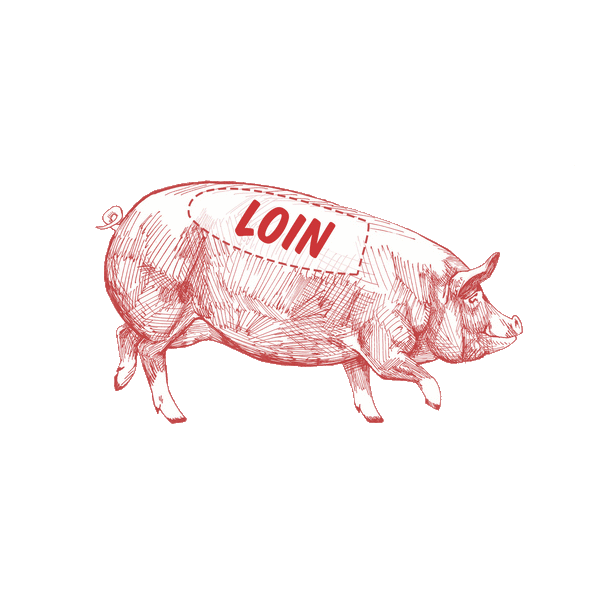

The most prime cut of the pig, the whole loin includes many individual cuts. Starting on the shoulder end lies the country rib roast: part shoulder, part chop. The center-cut loin, the most recognizable cut in the butcher case, is available bone-in, boneless, and cut into chops. Our top seller, the porterhouse or T-bone, connects to the back end of the loin and includes the coveted tenderloin. Medallions, loin bacon, back fat, skin, and even the baby back rib come from this most tender and juicy top section of the pig.
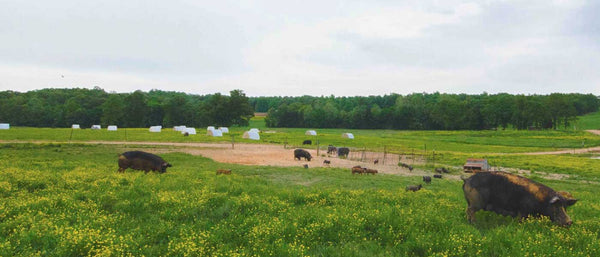
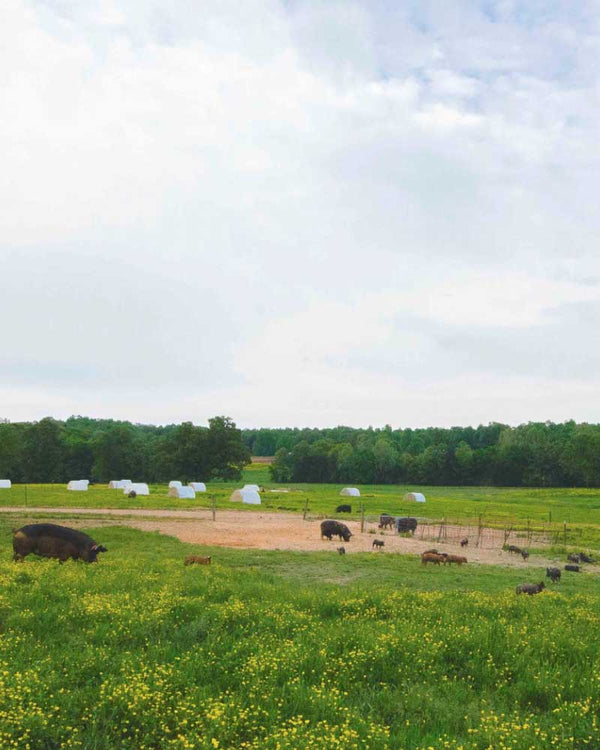
We champion a return to balanced, healthy, heritage breeds on American farms for the long term food security of the planet and the welfare of the animals.
© 2025, Heritage Foods Powered by Shopify
